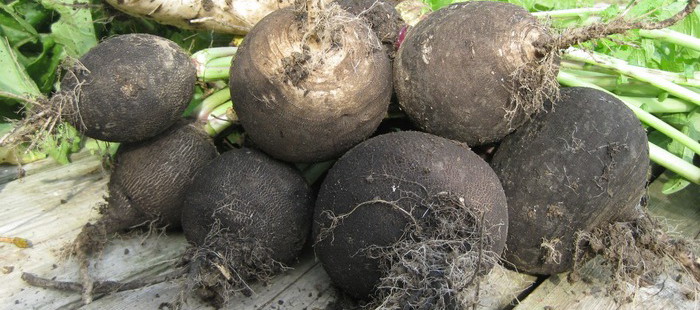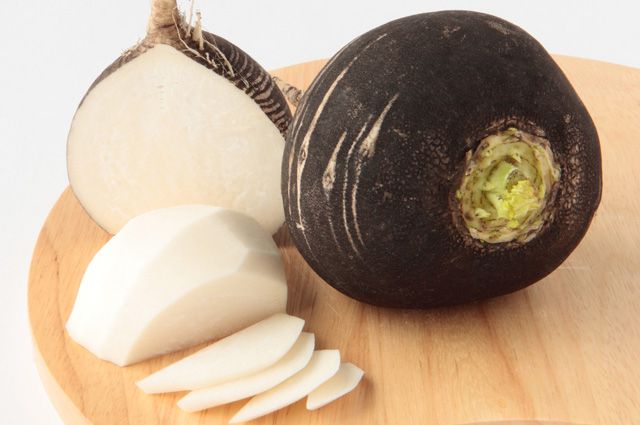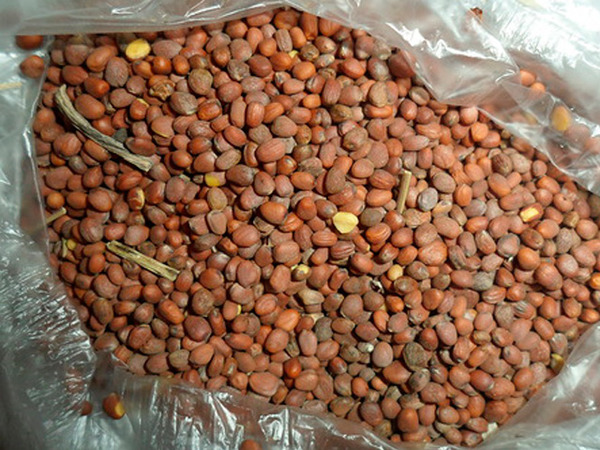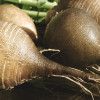Sowing or garden radish
Content
Description of the plant
Sowing radish is an annual or biennial crop reaching 0.9 meters in height. In the first year of life, it forms oblong leaves and a black root crop. The next year, a stem with many branches is formed, as well as inflorescences: white, pink or purple. Further, fruit-pods are formed from the flowers. Vegetable seeds are usually oval in shape, they are small and dark. The culture blooms in mid-spring, and its fruits ripen in early summer.
The most popular crops are black radish and Grayvoronskaya. The difference between them lies in the shape and color of the fruit: the first type of vegetable is round and black, and the second is cone-shaped and white. Also Grayvoronsky root vegetable tastes more bitter.
The seed-type radish is cultivated as a radish - small red or white roots, pungent in taste, and as a radish - large black fruits, pungent in taste.
The root of the culture is thick, in the form of a turnip or spindle. The plant is erect, petiolate, with a lot of news. The leaves located close to the ground are "cut", have the shape of a lyre, and the upper ones are whole, small, arranged alternately. In the middle of the pod fruit, there are many spherical black seeds.
Video "Everything about radish - from seed to cultivation"
In this video, you will see how to grow a radish.
Spreading
The Mediterranean is considered the birthplace of culture. A variety of wild radish grows in China, Japan and Korea. You can grow a vegetable in almost any climate, except for the desert and the conditions of the Far North. In general, on the territory of the country, the root crop is grown almost everywhere.
Part used
Usually only the root vegetable is used. The color of the root is black on the outside and white on the inside. Its taste "burns" with bitterness, and the smell can provoke tears. The taste of the vegetable is due to the glycoside unstable in the air, which secretes the essential oil. The juice of the culture contains vitamin C, which is known for its antibacterial action. Ascorbic acid, glycosides, lysozyme, which has a disinfecting effect, were found in the root of the plant. Also in this part of the plant are glucose, phytoncides, minerals (even iodine) and vitamins of group B and PP.
The root vegetables of the vegetable contain a large amount of carbohydrates, glycosides, substances containing nitrogen, fats and phytoncides. And also salts of potassium, sodium, iron, soda, chlorine, bromine and other substances.
It is because of the content of a number of chemicals and compounds in the root crop that it is widely used in pharmacology and medicine. The beneficial effect of radish on the human body in general and the digestive system in particular has long been noticed.
Medicines based on the plant have bactericidal, expectorant, bile and diuretic characteristics. Also, such drugs increase appetite, produce gastric juice and improve digestion, due to the large amount of fiber in culture. Sowing radish is also used for tuberculosis, for better absorption of carbohydrates by the body (especially in case of diabetes mellitus).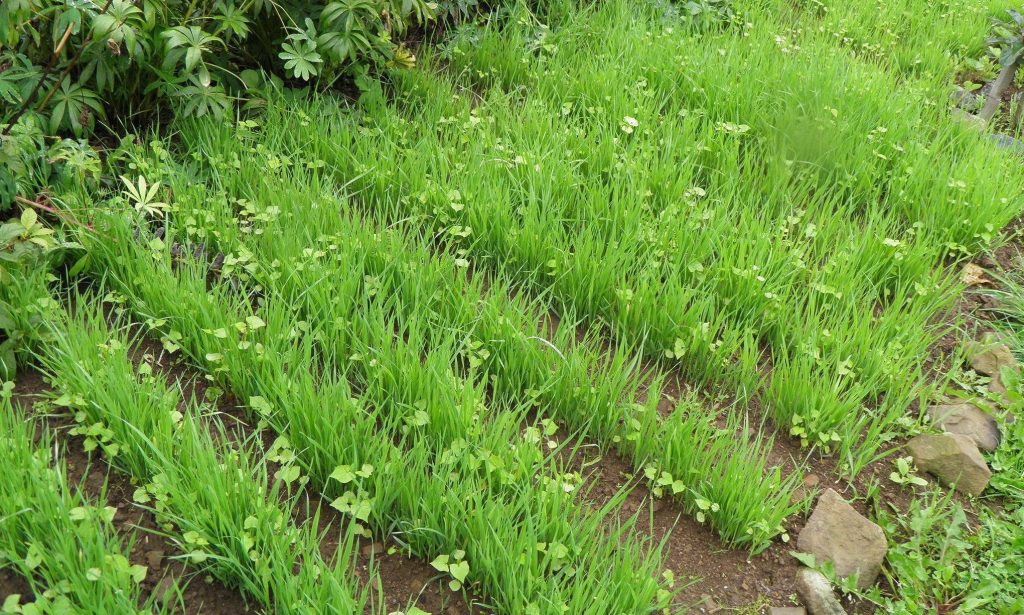
The plant has a positive effect on improving the digestion process, it also normalizes the secretion of bile and urine output. Root juice in an amount of 0.1 liters of 30% concentration, if introduced by probing, has a better choleretic effect than a solution of magnesia.
Some authors consider the use of radish productive in diseases of the liver and gallbladder, while others consider the use of culture in such diseases is strictly prohibited. The drugs created on the basis of the inoculated culture can have a negative effect in the acute development of diseases (hyperacid gastritis, acute inflammatory processes in the intestines, kidneys). However, for chronic diseases of these organs and in each specific situation, it is possible to use preparations containing radish in certain dosage forms and forms.
Vegetable juice in folk medicine is used very often. In particular, it is used for diseases of the respiratory tract: whooping cough, bronchitis, and even spitting up blood. A good effect is given by root vegetable juice and its grated pulp as a wound-healing agent for external use. Fresh juice can also be rubbed with sore joints, used for radiculitis, myositis, neuralgia. The juice of the culture with sugar will help establish the menstrual cycle and increase the abundance of secretions. Also, the root crop enhances milk production in nursing mothers. Radish juice is also used for cirrhosis and hepatitis. It has a positive effect on the normalization of the heart rate and helps in the treatment of cardioneuroses.
Tincture of seeds and roots is an excellent remedy for age spots.
It is impossible to use drugs based on root vegetables inside for stomach and duodenal ulcers, acute diseases of the kidneys and liver, which are accompanied by inflammation.
Radish is also used for dropsy and gout. With its help, you can often defeat worms!
Choline contained in radish stimulates the formation of phospholipids, which prevent fatty degeneration of the liver.
Ascorbic acid promotes the accumulation of glycogen, resulting in improved liver function.
Rafan and sulphurous oil, contained in root vegetables, enhances the formation and secretion of bile into the intestines, which perfectly prevents cholelithiasis. Therefore, the radish is often used by patients with cholecystitis.
Growing
The cultivation of the seed-type radish has similarities and differences with the cultivation of its closest relatives. Most often, root crop seeds are sown in early summer directly on the garden bed. After the sprouts grow up a little, they are thinned out, observing the gap between individuals of 0.15 - 0.2 meters. Radish, as mentioned above, grows well in almost any soil. However, it will be more productive to grow a vegetable in loose soil in the sun or in partial shade.
Collection and procurement
Usually, the root crop is harvested in the fall in the first year of the crop's life. They are dug up, cleaned from the ground, the tops are cut off and dried. After the vegetables are placed in a dark, cool place (cellar or basement), where they can be stored for a long time without losing their freshness.
So, the seed-type radish is an unpretentious vegetable that does not require specific growing conditions. However, the use of the root crop is quite wide. Because of its beneficial qualities and properties, radish is widely used in pharmacology. In addition, the vegetable is the basis for the preparation of many folk remedies. So you can safely grow radish in your garden and use the vegetable harvest productively!
Video "Harvesting Radish"
In this video, you will see how to harvest a radish.

